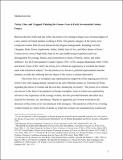Files in this item
Tricky, fine, and trapped : painting the femme forte in early seventeenth-century France
Item metadata
| dc.contributor.author | Knowles, Marika Takanishi | |
| dc.date.accessioned | 2020-04-18T23:32:20Z | |
| dc.date.available | 2020-04-18T23:32:20Z | |
| dc.date.issued | 2019-04-19 | |
| dc.identifier | 255919117 | |
| dc.identifier | 8bdaf810-9a56-459e-aa25-54dd5ccd3b4b | |
| dc.identifier | 85065329199 | |
| dc.identifier | 000465035000004 | |
| dc.identifier.citation | Knowles , M T 2019 , ' Tricky, fine, and trapped : painting the femme forte in early seventeenth-century France ' , Zeitschrift für Kunstgeschichte , vol. 82 , no. 1 , pp. 92-114 . https://doi.org/10.1515/ZKG-2019-0004 | en |
| dc.identifier.issn | 0044-2992 | |
| dc.identifier.uri | https://hdl.handle.net/10023/19820 | |
| dc.description.abstract | Between the late 1620s and late 1640s, Jacques Blanchard, Simon Vouet, and Claude Vignon all painted the femme forte (strong woman), an exemplary, heroic femal type whose popularity was linked to the presence of Marie de Medici and Anne of Austria on the royal stage of France. This article puts early seventeenth-century French paintings of femmes fortes into conversation with period discourse regarding the reception of paintings and the status of women. Pictorial representation tended to cast the femme forte into contexts that compromised her exemplary status. Nude, on the verge of death by her own hand, the figure of the femme forte invited the very kind of sensual consumption that the femme forte herself attempted to disavow. Yet the ultimate threat posed by the femme forte was that her image might ‘trick’ male viewers into unwise actions. Between the late 1620s and late 1640s, the femme forte (strong woman) was a favored subject of a new coterie of French painters working in Paris. The generic category of the femme forte comprised women from diverse historical and religious backgrounds, including Lucretia, Cleopatra, Dido, Portia, Sophonisbe, Esther, Judith, Joan of Arc, and Mary Queen of Scots.1 Femmes fortes were of high birth (Joan of Arc and Judith being exceptions) and were distinguished for courage, beauty, and commitment to ideals of family, nation, and noble selfhood.2 For the French painters Claude Vignon (1593– 1670), Jacques Blanchard (1600 – 1638), and Simon Vouet (1590 – 1649), the femme forte offered an opportunity to combine the female nude with a historical subject.3 For the femme forte, however, pictorial representation had the tendency to make her suffering into the object of the viewer’s sensual delectation. The femme forte as exemplary type represented an outgrowth of the ongoing querelle des femmes, the wide-ranging debate, initiated in the early fifteenth century by Christine de Pisan, regarding the merits of women and the role they should play in society.4 The femme forte offered one answer in the form of its pantheon of female exemplars, none of whom were particularly relevant to the experience of the average woman, but who provided dramatic and often racy material for literature, art, and theater. Despite its apparently pro-woman inclination, the discourse of the femme forte was interlaced with misogyny. The narratives of the lives of strong women fixated on violent forms of death, in which the woman was simultaneously exalted and annihilated at the same time, bloody endings that neglected to imagine women’s social role beyond instances of crisis. In France, interest in the femme forte was piqued as a result of the presence on the royal stage of Marie de Medici, queen of France between 1601 and 1610 and then regent for her minor son Louis XIII between 1610 and 1614. Within the distinctive cultural and social milieus of the Paris of Louis XIII, the femme forte was a subject of profound contemporary relevance, the representation of which revealed uncomfortable truths about myths of female heroism and the seductions of flesh and paint.5 The sensational nature of the strong woman’s heroic death interacted in problematic ways with artistic techniques, most notably with the use of colorist manners of painting. When artists working in a colorist idiom painted the femme forte, they gave her a body that resonated with contemporary moralists’ condemnation of women’s bodies as dangerous instruments of seduction. If colorism was not at issue, other elements of the painting’s mise-en-scène, in particular the setting of the bed and the ruelle, could work in similar ways to ensnare the image of the femme forte in a network of associations that challenged her exemplarity. When put into conversation with period texts and cultural contexts, paintings of the femme forte by Blanchard, Vignon, and Vouet expose the problematic misalignments between the myth of the exemplary woman and social realities specific to the early seventeenth century. | |
| dc.format.extent | 633092 | |
| dc.language.iso | eng | |
| dc.relation.ispartof | Zeitschrift für Kunstgeschichte | en |
| dc.subject | ND Painting | en |
| dc.subject | T-NDAS | en |
| dc.subject | SDG 5 - Gender Equality | en |
| dc.subject.lcc | ND | en |
| dc.title | Tricky, fine, and trapped : painting the femme forte in early seventeenth-century France | en |
| dc.type | Journal article | en |
| dc.contributor.institution | University of St Andrews. School of Art History | en |
| dc.identifier.doi | https://doi.org/10.1515/ZKG-2019-0004 | |
| dc.description.status | Peer reviewed | en |
| dc.date.embargoedUntil | 2020-04-19 | |
| dc.identifier.url | https://www.degruyter.com/view/j/zkg.2019.82.issue-1/ZKG-2019-0004/ZKG-2019-0004.xml?format=INT | en |
This item appears in the following Collection(s)
Items in the St Andrews Research Repository are protected by copyright, with all rights reserved, unless otherwise indicated.

